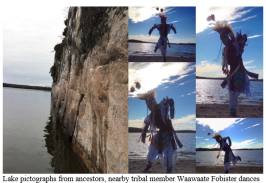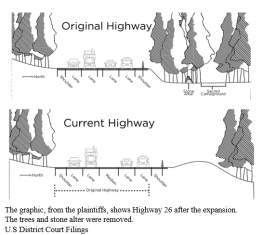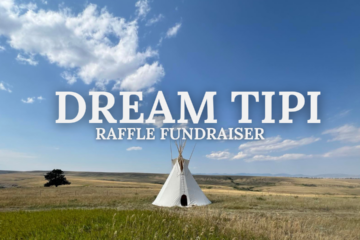Stories of Indigenous Stewardship
October 27, 2017
S. Calling Last, MIM
This series highlight the relentless efforts of Indigenous communities across North America to protect their significant areas from destruction. Harming livelihood and health, the destruction is violating the right to fully practice cultural traditions. Meaningful government-to-government tribal consultation has not taken place and what has is deceitful and not in favor of Indigenous nations. The list below shows that this practice of ignoring Tribal Nation concerns, is not new and shows no signs of improving. Back room collaborations between government officials and industries have resulted in irreversible environmental disasters. But Tribes have not backed down and are stepping up to fight for their rights, and the rights to a clean environment for the rest of Canada and the U.S.
Here are three stories of Indigenous communities and their fight for environmental justice:
- Grassy Narrows and Wabaseemoog First Nations, Ontario
 First Nations in Ontario Canada have been exposed to harmful levels of mercury contamination in the Wabigoon River system where 90% of the people show signs of mercury poisoning. This is a direct result from Reed Paper dumping mercury upstream of the communities nearly six decades ago. The impact to the health of the community is alarming and the impact to cultural practices and traditional food systems has had an equally dismal impact. The unborn babies and youth are experiencing developmental impairments, reduced ability in thinking, attention span, and motor skills impairment. Other symptoms experienced by the community range from mood swings, nervousness, and emotional changes to tremors, kidney malfunction, respiratory failure and death. This is made all the more heart breaking with Grassy Narrows 2016 State of Emergency declaration over the amount of youth suicides. In June, the province of Ontario committed $85 million to clean up the gross neglect. Work is scheduled to begin in 2018 and we will be watching closely for clean up shenanigans like those happening at Onondaga Lake.
First Nations in Ontario Canada have been exposed to harmful levels of mercury contamination in the Wabigoon River system where 90% of the people show signs of mercury poisoning. This is a direct result from Reed Paper dumping mercury upstream of the communities nearly six decades ago. The impact to the health of the community is alarming and the impact to cultural practices and traditional food systems has had an equally dismal impact. The unborn babies and youth are experiencing developmental impairments, reduced ability in thinking, attention span, and motor skills impairment. Other symptoms experienced by the community range from mood swings, nervousness, and emotional changes to tremors, kidney malfunction, respiratory failure and death. This is made all the more heart breaking with Grassy Narrows 2016 State of Emergency declaration over the amount of youth suicides. In June, the province of Ontario committed $85 million to clean up the gross neglect. Work is scheduled to begin in 2018 and we will be watching closely for clean up shenanigans like those happening at Onondaga Lake.
- Onondaga Lake, New York

Dubbed the most polluted lake in America, Onondaga Lake is traditional land of the Onondaga Nation or People of the Hills who are central firekeepers of the Haudenosaunee or People of the Longhouse, more commonly known as the Iroquois Confederacy. This sacred lake was rich with longhouses and cabins until George Washington ordered troops in 1779 to attack Onondaga men, women, and children and burn more than 8 miles of villages and crops. The Industrial Revolution brought increased waves of destruction with the dumping of toxic chemicals into the lake, lasting unregulated until the US Environmental Protection Agency was created in 1970. Beginning in 1884, soda ash production began, a substance used to make glass, chemicals, detergents, and paper. Mercury, chlorine and other chemical waste was dumped directly into the lake. Swimming was banned in 1920 and in 1994 EPA designated the lake a superfund site. Honeywell, predecessor of past companies responsible of dumping, agreed to partial cleanup of the lake and has removed, through a process called dredging, 2.2 million cubic yards of toxic lake-bottom, capping it with 3 million cubic yards of sand, costing hundreds of millions of dollars. Honeywell claims the clean-up is a success and that the lake will restore to its natural beauty and value. The Onondaga Nation located 11 miles south of the lake sees it differently, and filed a lawsuit alleging they were not properly consulted on clean up remedies and that the remedies themselves were insufficient. Actual clean up only involved a small percentage of the most contaminated lake-bottom. Onondaga Nation are standing strong in defense and demand nothing less than full cleanup of the lake and restoration of its shorelines. Newer threats increase daily with the discharge of effluent wastewater containing pharmaceuticals. Some reports show 20% of the water flowing into the lake comes from the county water treatment plant. The entire ecosystem as be disrupted.
- Yakama and Grande Ronde Burial Sites, Oregon

Environmental justice issues concerning Indigenous Nations almost always include a violation of the Native American Religious Freedom Act. This is the case for Yakama and Grande Ronde Nations and protection of their ancestral burial site near Mt. Hood in Oregon. A stone altar, medicinal plants, a traditional camp site and an ancestral burial ground were destroyed in 2008 when Oregon Department of Transportation expanded a section of highway. This significant place is sacred to the Yakama Nation and Confederated Tribes of Grande Ronde. Tribal elders with help from local alliances sued the federal government alleging the expansion could have been rerouted and that it violated the Religious Freedom Restoration Act.
The long standing dispute was recently escalated when U.S. Justice Department attorney Ben Schifman motioned a federal judge to dismiss the lawsuit, stating tribal elders were not substantially burdened by the expansion and lacked standing to sue because the elders have not been denied a public benefit or forced to violate their religion. The elders are simply asking the judge to say that the federal government broke the law. The site has been used by tribal members from time immemorial as they approached sacred Mt. Hood as a resting stop and religious campground. The Grande Ronde know it as Ana Kwna Nchi chi Patat, or the Place of Big Trees. The federal judge has not made it public as to when a decision will be made, but any decision will set precedence across Indian Country for interpreting The Native American Religious Freedom Act and other battles to protect sacred places. The hope is that the judge will stop letting government officials like attorney Schifman say what is best for Indian people and that justice be restored for Indigenous peoples.


